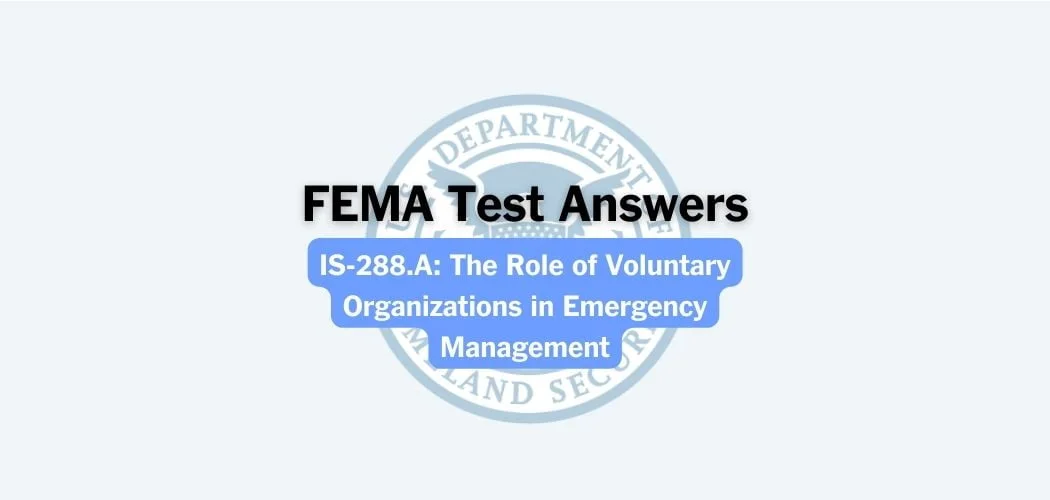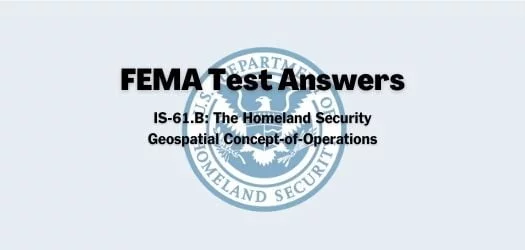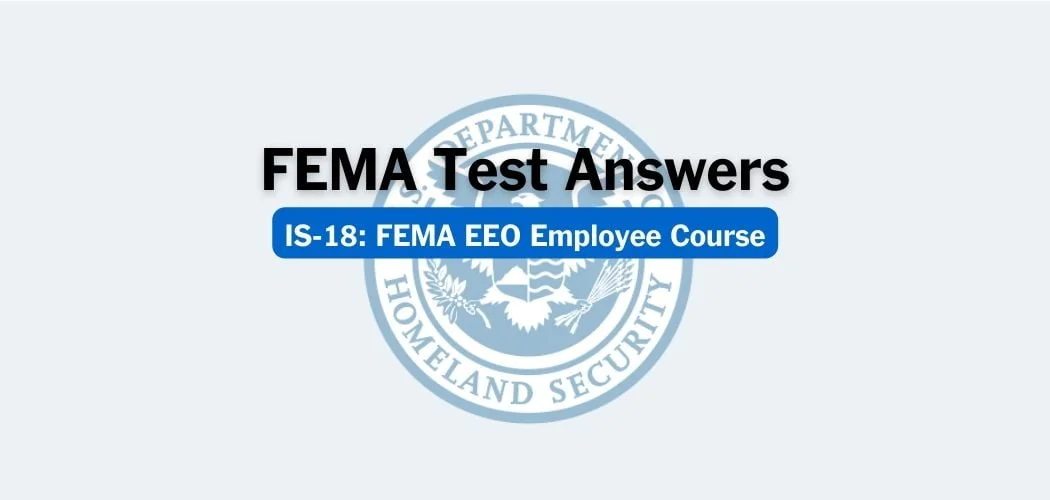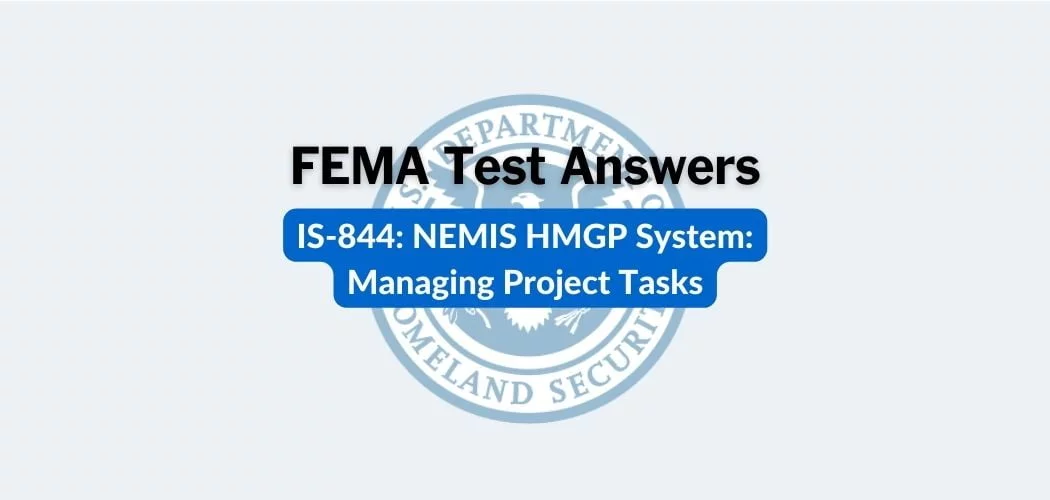Overview: The FEMA IS-274 course was published on 3/20/2020 to provide the participants with the knowledge and skills required to access and properly use a FIS to determine the flood risk for a property, and allow participants to take actions that may prevent flood disasters or insure against losses caused by floods.
Course objectives: identify information contained in the Flood; Insurance Study (FIS); explain what the information in the FIS means; describe how to use the information in the FIS.
FEMA IS-274 test answers
Each time this test is loaded, you will receive a unique set of questions and answers. The test questions are scrambled to protect the integrity of the exam.
Question 1. For a location in a riverine floodplain, what is used to determine an accurate Base Flood Elevation (BFE)?
A. Stillwater Elevations (SWELs)✅
B. Summary of Discharges Table
C. Transect
D. Flood Profile
Question 2. Which is an example of a Riverine Hydrologic method of analysis?
A. Roughness coefficients
B. Stillwater Elevations (SWELs)
C. Drainage area discharge curves✅
D. Digital Elevation Models (DEMs)
Question 3. In addition to the location of transects, what other data is found on the transect location map or new Flood Insurance Rate Map (FIRM) panels?
A. Name of transects
B. Numbering of transects✅
C. Coordinates of transects
D. Source of transects
Question 4. Which of the following is most likely to be included in Flood Insurance Study (FIS) Section 2.2 – Community Description?
A. Historical flood data
B. Identification of flood sources
C. Average rainfall and temperature✅
D. Gage station locations
Question 5. For which program does the Flood Insurance Study (FIS) list authorities?
A. Federal Aid Programs For Disaster Recovery
B. National Continuity Programs (NCP)
C. Hazard Mitigation Grant Program (HMGP)
D. National Flood Insurance Program (NFIP)✅
Question 6. What do floodplain boundaries show?
A. The transect locations and transect numbers
B. The flood channels in AR Zones
C. The areas that would be inundated by a flood of a given frequency✅
D. The discharges and drainage areas at locations along the streams
Question 7. What is referenced to a specific vertical datum?
A. Manning’s “n” values
B. Astronomic tide effects
C. All of the flood elevations, including those listed in the tables in the Flood Insurance Study (FIS)✅
D. Radius from storm center to maximum winds
Question 8. What is the amount of water, combined with the effect of normal tides, that is pushed toward the shore during a storm?
A. Forcing functions
B. Wave setup
C. Storm surge✅
D. Wave runup
Question 9. Authority for the National Flood Insurance Program (NFIP) identifies the National Flood Insurance Act (1968), the Flood Disaster Protection Act (FDPA) of 1973, the National Flood Insurance Reform Act (NFIRA) of 1994, the Homeowner Flood Insurance Affordability Act (HFIAA) of 2014, and which one of the following?
A. The Homeowner Protection Act
B. Flood Control Act of 1944
C. The Biggert-Waters Flood Insurance Reform Act of 2012✅
D. The Insurance Act of 2015
Question 10. What is calculated by taking into account the storm surge stillwater elevation, wave height above the storm surge stillwater elevation, amount of wave setup, and wave runup (where present)?
A. Summary of Stillwater Elevations
B. Riverine Hydraulic Analyses
C. Flood Zone Boundaries
D. Coastal area base flood elevations (BFEs)✅
Question 11. The flood profiles must be used to accurately determine which of the following?
A. Zone designations
B. Base Flood Elevation (BFE) for a location in a riverine floodplain✅
C. Stillwater Elevations (SWELs)
D. Summary of Discharges
Question 12. Which of the following is a report prepared by the Federal Emergency Management Agency (FEMA) that summarizes an analysis of the flood risks in a community?
A. Flood Insurance Study (FIS)
B. Flood Insurance Rate Map (FIRM)✅
C. Federal Emergency Management Agency (FEMA) Insurance Settlement Report
D. Federal Emergency Management Agency (FEMA) Mitigation Assessment Team (MAT) Reports
Question 13. Flood Insurance Study (FIS) Section 2.1 – Scope of Study: Identification of Flood Sources names the streams studied by which two methods?
A. Drainage Areas and Discharge Curves
B. Hydraulic and Hydrological Curves
C. Detailed methods and approximate analyses✅
D. Riverine and Coastal analysis
Question 14. Which of the following are shown with tints (shading), screens (patterns), or symbols on a Flood Insurance Rate Map (FIRM)?
A. The locations of selected cross sections used in the hydraulic analyses and floodway computations✅
B. Drainage area discharge curves
C. Stillwater Elevation (SWEL)
D. Starting water surface elevations
Question 15. What two study methods used for the identification of flood sources are discussed in Flood Insurance Study (FIS) Section 2.1 – Scope of Study?
A. Riverine and Coastal analysis
B. Drainage Areas and Discharge Curves
C. Hydraulic and Hydrological Curves
D. Detailed methods and approximate analyses✅
Question 16. Which section of the Flood Insurance Study (FIS) would contain the following statement? “The coastal areas of Flood County are subject to flooding from tidal surges associated with hurricanes.”
A. Flood Insurance Study (FIS) Section 2.2 – Community Description?
B. Flood Insurance Study (FIS) Section 2.1 – Scope of Study
C. Flood Insurance Study (FIS) Section 2.3 – Principal Flood Problems?
D. Flood Insurance Study (FIS) Section 2.4 – Flood Protection Measures✅
Question 17. Which of the following is most likely to be included in Flood Insurance Study (FIS) Section 2.2 – Community Description?
A. Historical flood data
B. Identification of flood sources
C. Gage station locations
D. Size and population of the community✅
Question 18. Which type of engineering method is associated with studies of the amount of water flowing in a stream during flood events?
A. Wave height analysis
B. Stillwater elevations
C. Hydrologic analysis✅
D. Starting water surface elevations
Question 19. Which of the following are shown with tints (shading), screens (patterns), or symbols on a Flood Insurance Rate Map (FIRM)?
A. Drainage area discharge curves
B. Starting water surface elevations
C. Floodways✅
D. Stillwater Elevation (SWEL)
Question 20. What is referenced to a specific vertical datum?
A. Manning’s “n” values
B. Astronomic tide effects
C. Radius from storm center to maximum winds
D. All of the flood elevations✅
Question 21. Which is an example of a Flood Protection Measure?
A. Floodplain boundaries
B. Dams✅
C. Discharge tables
D. Stream or tide gages
Question 22. What kind of information would you find in Flood Insurance Study (FIS) Section 2.4 – Flood Protection Measures?
A. Descriptions of man-made structural and non-structural flood control measures, including levees✅
B. Historical flood data
C. Identification of flood sources studied by detailed and approximate methods
D. Information about the location and physical characteristics such as elevation range and topography
Question 23. Flood Insurance Study (FIS) Section 4.2 – Floodways defines the floodway and describes how floodways were determined. What does this section list?
A. Historical flood data✅
B. Which communities have detailed studies
C. Which streams have floodways
D. Studies that determine the flood height or water surface elevations
Question 24. Which Section of the Flood Insurance Study (FIS) details which communities are included in the FIS?
A. Flood Insurance Study (FIS) Section 1.3 – Coordination
B. Flood Insurance Study (FIS) Section 1.1 – Purpose
C. Flood Insurance Study (FIS) Section 2.1 – Scope of Study
D. Flood Insurance Study (FIS) Section 2.2 – Community Description✅
Question 25. Flood Insurance Study (FIS) Section 4.1 – Floodplain Boundaries indicates factors used to delineate the floodplain boundaries, including the contour intervals or topographic accuracy, dates of the topographic model or maps, and which of the following?
A. Stillwater Elevation (SWEL)
B. Scales✅
C. Vertical datum
D. Astronomic tide effects
Question 26. What must be used when determining an accurate Base Flood Elevation (BFE) for a location in a riverine floodplain?
A. Flood Profile✅
B. Transect
C. Summary of Discharges Table
D. Zone designations
Question 27. Which of the following is most likely to be included in Flood Insurance Study (FIS) Section 2.2 – Community Description?
A. Identification of flood sources
B. Names of the adjacent communities✅
C. Historical flood data
D. Gage station locations
Question 28. Which is one of the sources of data used in Riverine Hydraulic analyses?
A. Cross sections✅
B. Soil information
C. Gage data
D. Topographical maps
Question 29. What is delineated by using flood elevations at cross-sections or transects and by interpolating between cross-sections or transects using topographic maps?
A. Scales
B. Floodplains✅
C. Water surface elevations
D. Base Flood Elevations (BFEs)
Question 30. Authority for the National Flood Insurance Program (NFIP) identifies the National Flood Insurance Act (1968), the National Flood Insurance Reform Act (1994), the Biggert-Waters Flood Insurance Reform Act (2012), the Homeowner Flood Insurance Affordability Act (HFIAA) of 2014 and which one of the following?
A. Flood Control Act of 1944
B. The Flood Disaster Protection Act (FDPA) of 1973✅
C. The Homeowner Protection Act
D. The Insurance Act of 2015
Question 31. Where would you look for a list of previous FISs that have been superseded by the publication of the new FIS?
A. Flood Insurance Study (FIS) Section 7.0 – Other Studies✅
B. Flood Insurance Study (FIS) Section 6.0 – Flood Insurance Rate Map (FIRM)
C. Flood Insurance Study (FIS) Section 8.0 – Location of Data
D. Flood Insurance Study (FIS) Section 10.0 – Revisions
Question 32. What represents a portion of the shoreline in which ground cover and ground elevations are similar, particularly during a storm event?
A. Transect✅
B. Stillwater intercept
C. Cross section
D. Hypothetical slope
Question 33. Which of the following are shown with tints (shading), screens (patterns), or symbols on a Flood Insurance Rate Map (FIRM)?
A. Stillwater Elevation (SWEL)
B. The 1- and 0.2-percent-annual-chance floodplains✅
C. Starting water surface elevations
D. Drainage area discharge curves
Question 34. Which of the following would you expect to find in Flood Insurance Study (FIS) Section 8.0 – Location of Data?
A. The address of the software companies who own the programs used to process study data
B. The address of the contractor who performed the Flood Insurance Study (FIS)
C. The address of the North American Vertical Datum (NAVD) regional office for the area studied
D. The address of the Community Map Repository (CMR)✅
Question 35. Which of the following is most likely to be included in Flood Insurance Study (FIS) Section 2.3 – Principal Flood Problems?
A. Historical flood data✅
B. Sources of data
C. Soil types
D. Average rainfall and temperature
Question 36. Which of the following is most likely to be included in Flood Insurance Study (FIS) Section 2.3 – Principal Flood Problems?
A. Sources of data
B. Soil types
C. Average rainfall and temperature
D. Past major floods✅
Question 37. Flood Insurance Study (FIS) Section 4.1 – Floodplain Boundaries indicates factors used to delineate the floodplain boundaries, including the scales, contour intervals or topographic accuracy, and which of the following?
A. Vertical datum
B. Stillwater Elevation (SWEL)
C. Dates of the topographic model or map✅
D. Astronomic tide effects
Question 38. Which is an example of a Flood Protection Measure?
A. Discharge tables
B. Stream or tide gages
C. Levees✅
D. Floodplain boundaries
Question 39. Which type of engineering method is associated with studies of flood height or elevation?
A. Hydraulic analysis✅
B. Gage data analysis
C. Drainage area discharge curves
D. Rainfall-runoff models
Question 40. Multiple flood events may be included in the flood profile. Which of the following is always included?
A. 10-percent annual chance (10 years)
B. 1-percent annual chance (100-year)✅
C. 4-percent annual chance (25 years)
D. 2-percent annual chance (50 years)
Question 41. For insurance applications, areas on Flood Maps are designated by zones. Which of the following best describes the basis for these zones?
A. The vertical datum used for the information in the hydraulic analysis
B. The historical flood data
C. The locations of selected cross sections used in the hydraulic analyses and floodway computations
D. The flood risk potential computed in the analysis✅
Question 42. How is the flood risk potential computed in the analysis expressed for insurance applications?
A. As cross-sections
B. As transects
C. As zone designations✅
D. As floodway data tables



